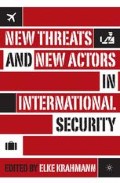Abstract
The use and misuse of Small Arms and Light Weapons (SALW) are estimated to result in over 500,000 deaths per year, and countless injuries.1 For example, one often cited statistic indicates that in 90 percent of conflicts since 1990, SALW have been the only weapons used in fighting, and have contributed to between 30 and 90 percent of civilian deaths in those conflicts.2 SALW were used extensively in the organization and conduct of the Rwandan Genocide; are the primary weapons of narco-insurgents and paramilitaries in Colombia; and are the dominant tools of ongoing insurgency in Iraq, to name but a few examples. Their widespread availability and misuse contributes to transnational organized crime and conflicts of all types, and is closely related to current concerns such as weak and collapsed states, human rights abuses, and the pantheon of both traditional and nontraditional security issues. They are the tools of the trade for terrorists, rebels, and criminals and their spread has gone largely unchecked for many decades.
Access this chapter
Tax calculation will be finalised at checkout
Purchases are for personal use only
Preview
Unable to display preview. Download preview PDF.
Notes
Edward Laurance, Light Weapons and Intrastate Conflict; Early Warning Factors and Preventive Action: A Report to the Carnegie Commission on Preventing Deadly Conflict (New York: Carnegie Corporation of New York, 1998), 12, 20–2.
Keith Krause, Small Arms and Light Weapons: Proliferation Processes and Policy Options (paper, International Security Research and Outreach Programme, International Security Bureau, July 2000), at http://www.smallarmssurvey.org, 2.
Michael T. Klare, “Light Weapons Diffusion and Global Violence in the Post-Cold War Era,” in Light Weapons and International Security, ed. Jashit Singh, 1–40 (London: BASIC, 1995).
Michael Renner, Small Arms, Big Impact: The Next Challenge of Disarmament, Worldwatch Paper No. 137 (Washington, D.C.: World watch Institute, 1997), 19.
Michael T. Klare, “The International Trade in Light Weapons: What Have We Learned?” in Light Weapons and Civil Conflict: Controlling the Tools of Violence, ed. Jeffrey Boutwell and Michael T. Klare (NewYork: Carnegie Commission on Preventing Deadly Conflict, 1999), 15.
Aaron Karp, “The Rise of Black and Gray Markets,” The Annals of The American Academy of Political and Social Science 535 (1994): 175–89; and Jasjit Singh, “Illicit Trafficking in Small Arms: Some Issues and Aspects,” in Curbing Illicit Trafficking in Small Arms and Sensitive Technologies: An Action-Oriented Agenda, ed. Pericles Gasparani Alves and Daiana Belinda Cipollone, 9–18 (Geneva: UNIDIR, 1998).
See David Mussington, Understanding Contemporary Arms Transfers: An Analysis of the Post-Cold War Arms Trade and Supplier Strategies for Limiting Conventional Weapons Proliferation, Adelphi Paper 291 (London: Brassey’s for IISS, 1994), 58.
John Stockwell, In Search of Enemies: A CIA Story (London: André Deutsch, 1978), 59.
David Keen, The Economic Functions of Violence in Civil Wars, Adelphi Paper 320 (London: International Institute for Strategic Studies, 1998). William Reno, “Privatizing War in Sierra Leone,” Current History 96, no. 610 (1997): 227–30; William Reno, “The Business of War in Liberia,” Current History 95, no. 601 (1996): 211–15; William Reno, “War, Markets, and the Reconfiguration of West Africa’s Weak States,” Comparative Politics 29, no. 4 (1997): 493–510; Mats Berdal and David Malone, eds., Greed and Grievance: Economic Agendas in Civil Wars (London: Lynne Rienner, 2000).
R.T. Naylor, “The Insurgent Economy: Black Market Operations of Guerrilla Organizations,” Crime, Law and Social Change 20, no. 1 (1993): 41.
See, e.g., Robert Fowler, Report of the Panel of Experts on Violations of Security Council Sanctions Against UNITA (New York: United Nations, 2000), paragraphs 83–8; Global Witness, A Rough Trade: The Role of Companies and Governments in the Angolan Conflict (London: Global Witness, December 1998), 12; Ian Smillie, Lansana Gberie, and Ralph Hazleton, The Heart of the Matter: Sierra Leone, Diamonds and Human Security (Ottowa: Partnership Africa Canada, 2000).
Fowler, Report of the Panel of Experts, paragraph 81.
Naylor, “Loose Cannons,” 20.
“SUDAN: Secret Weapons,” Africa Confidential 36, no. 10 (1995), 8.
Naylor, “Loose Cannons,” 37.
Chalk, “The Tamil Tiger Insurgency,” 75–7.
Ibid., 80.
They have also operated with a significant degree of autonomy in the regional black-market, with operations in Afghanistan, Myanmar, and Singapore, as well as further afar such as South Africa. Ibid., 79–82; and Tara Kartha, Tools of Terror: Light Weapons and India’s Security (New Delhi: Knowledge World, 1999), 150.
Rohan Gunaratna, Inside Al Qaida (London: Hurst and Company, 2002), 59–60.
Ibid., 58–9.
Small Arms Survey, Small Arms Survey 2003, 73.
Full title: The Protocol against the Illicit Manufacturing of and Trafficking in Firearms, Ammunition and Other Related Material.
See discussion of the protocol in Sarah Meek, “Combating Arms Trafficking: Progress and Prospects,” in Running Guns, 183–207. See also UN Press Release GA/9866, May 31, 2001.
UN, Report of the United Nations Conference on the Illicit Trade in Small Arms and Light Weapons in All Its Aspects (New York: UN, 2001).
William Benson, Light Weapons Controls and Security Assistance: A Review of Current Practice (London: Saferworld and International Alert, 1998), 30. This convention promotes information exchange and interstate cooperation on eradicating the illicit production and trade of light weapons. It was negotiated through the OAS, and is hoped to provide a model for other regional initiatives. It also provided a model for the UN ECOSOC Firearms Protocol.
Ibid., 28.
The text of the moratorium and other resources on its implementation can be found at http://www.nisat.org.
For an overview of these regional measures and their implementation see Biting the Bullet, Implementing the Programme.
Editor information
Copyright information
© 2005 Elke Krahmann
About this chapter
Cite this chapter
Bourne, M. (2005). The Proliferation of Small Arms and Light Weapons. In: Krahmann, E. (eds) New Threats and New Actors in International Security. Palgrave Macmillan, New York. https://doi.org/10.1057/9781403981660_8
Download citation
DOI: https://doi.org/10.1057/9781403981660_8
Publisher Name: Palgrave Macmillan, New York
Print ISBN: 978-1-349-52984-1
Online ISBN: 978-1-4039-8166-0
eBook Packages: Palgrave Political & Intern. Studies CollectionPolitical Science and International Studies (R0)

